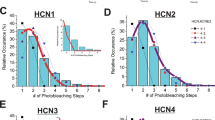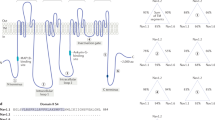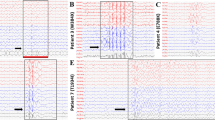Abstract
Ion channels are crucial for the normal function of excitable tissues such as neurons and skeletal muscle. Since the discovery that the paroxysmal muscle disorder periodic paralysis is caused by mutations in genes that encode voltage-gated ion channels, many genetic neurological channelopathies have been defined. These channelopathies include epilepsy syndromes that show a mendelian pattern of inheritance, certain forms of migraine and disorders of cerebellar function, as well as periodic paralysis. The clinical diversity of these disorders relates in part to the tissue-specific expression of the dysfunctional channel, but is probably influenced by other, as yet unidentified, genetic and non-genetic factors. The complementary disciplines of molecular genetics and cellular and in vitro electrophysiology have resulted in significant advances in understanding of the basic molecular pathophysiology of some of these disorders. The single-gene neurological channelopathies are generally regarded as a paradigm for understanding common human paroxysmal disorders, such as epilepsy and migraine. This article reviews the clinical and molecular features of some of the single-gene channelopathies that affect muscle and brain. The possible role of ion-channel functional and genetic variation in predisposing individuals to common forms of human epilepsy and migraine are also considered. The implications for accurate genetic diagnosis and therapeutic intervention are highlighted.
Key Points
-
The normal function of neurological tissues, such as brain, peripheral nerves and skeletal muscle, relies on the complex interplay between key ion channels, which determine membrane excitability
-
It is becoming clear that genetically induced dysfunction of ion channels is the underlying cause of many single-gene neurological diseases, including forms of periodic paralysis, myotonia, episodic ataxias, migraine and epilepsy
-
Mutations in the voltage-gated sodium and calcium channel genes SCN4A and CACNA1S, and the voltage-independent potassium channel gene KCNJ2, are associated with human periodic paralysis
-
Myotonia can result from mutations in either the muscle voltage-gated chloride channel gene CLCN1 or the voltage-gated sodium channel gene SCN4A
-
Single-gene epilepsy disorders have been associated with mutations in genes that encode sodium channel subunits, potassium channels, nicotinic acetylcholine receptor subunits and chloride channels
-
Episodic ataxia type 1 (EA1) is associated with mutations in the voltage-gated potassium channel gene KCNA1, whereas EA2 is caused by mutations in the calcium channel gene CACNA1A
-
Mutations in three genes—CACNA1A, ATP1A2 and SCN1A—have been found to cause familial hemiplegic migraine
This is a preview of subscription content, access via your institution
Access options
Subscribe to this journal
Receive 12 print issues and online access
$209.00 per year
only $17.42 per issue
Buy this article
- Purchase on Springer Link
- Instant access to full article PDF
Prices may be subject to local taxes which are calculated during checkout


Similar content being viewed by others
References
Kullmann DM and Hanna MG (2002) Neurological disorders caused by inherited ion-channel mutations. Lancet Neurol 1: 157–166
Graves TD and Hanna MG (2005) Neurological channelopathies. Postgrad Med J 81: 20–32
Jiang et al. (2003) X-ray structure of a voltage dependant potassium channel. Nature 423: 33–48
Ptacek LJ et al. (1992) Mutations in an S4 segment of the adult skeletal muscle sodium channel cause paramyotonia congenita. Neuron 8: 891–897
Fontaine B et al. (1990) Hyperkalemic periodic paralysis and the adult muscle sodium channel alpha-subunit gene. Science 250: 1000–1002
Rojas CV et al. (1991) A Met-to-Val mutation in the skeletal muscle Na+ channel α-subunit in hyperkalaemic periodic paralysis. Nature 354: 387–389
Jurkat-Rott K et al. (1994) A calcium channel mutation causing hypokalemic periodic paralysis. Hum Mol Genet 3: 1415–1419
Ptacek LJ et al. (1991) Identification of a mutation in the gene causing hyperkalemic periodic paralysis. Cell 67: 1021–1027
Ptacek LJ et al. (1994) Sodium channel mutations in acetazolamide-responsive myotonia congenita, paramyotonia congenita, and hyperkalemic periodic paralysis. Neurology 44: 1500–1503
Ptacek LJ et al. (1994) Dihydropyridine receptor mutations cause hypokalemic periodic paralysis. Cell 77: 863–868
Plaster NM et al. (2001) Mutations in Kir2.1 cause the developmental and episodic electrical phenotypes of Andersen's syndrome. Cell 105: 511–519
Koch MC et al. (1992) The skeletal muscle chloride channel in dominant and recessive human myotonia. Science 257: 797–800
Kubisch C et al. (1998) ClC-1 chloride channel mutations in myotonia congenita: variable penetrance of mutations shifting the voltage dependence. Hum Mol Genet 7: 1753–1760
Wu FF et al. (2002) Novel CLCN1 mutations with unique clinical and electrophysiological consequences. Brain 125: 2392–2407
Bendahhou S et al. (1999) Activation and inactivation of the voltage-gated sodium channel: role of segment S5 revealed by a novel hyperkalaemic periodic paralysis mutation. J Neurosci 19: 4762–4771
Hayward LJ et al. (1999) Defective slow inactivation of sodium channels contributes to familial periodic paralysis. Neurology 52: 1447–1453
Lehmann-Horn F et al. (1987) Adynamia episodica hereditaria with myotonia: a non-inactivating sodium current and the effect of extracellular pH. Muscle Nerve 10: 363–374
Hanna MG et al. (1998) Salbutamol treatment in a patient with hyperkalaemic periodic paralysis due to a mutation in the skeletal muscle sodium channel gene (SCN4A). J Neurol Neurosurg Psychiatry 65: 248–250
Hoskins B et al. (1975) Hyperkalemic periodic paralysis: effects of potassium, exercise, glucose, and acetazolamide on blood chemistry. Arch Neurol 32: 519–523
Davies NP et al. (2000) Clinical, electrophysiological, and molecular genetic studies in a new family with paramyotonia congenita. J Neurol Neurosurg Psychiatry 68: 504–507
Weckbecker K et al. (2000) Different effects of mexiletine on two mutant sodium channels causing paramyotonia congenita and hyperkalemic periodic paralysis. Neuromuscul Disord 10: 31–39
Ricker K et al. (1994) Myotonia fluctuans: a third type of muscle sodium channel disease. Arch Neurol 51: 1095–1102
Cannon SC (1996) Sodium channel defects in myotonia and periodic paralysis. Ann Rev Neurosci 19: 141–164
Bulman DE et al. (1999) A novel sodium channel mutation in a family with hypokalemic periodic paralysis. Neurology 53: 1932–1936
Davies NP et al. (2001) Sodium channel gene mutations in hypokalemic periodic paralysis: an uncommon cause in the UK. Neurology 57: 1323–1325
Sternberg D et al. (2001) Hypokalaemic periodic paralysis type 2 caused by mutations at codon 672 in the muscle sodium channel gene SCN4A. Brain 124: 1091–1099
Jurkat-Rott K et al. (2000) Voltage-sensor sodium channel mutations cause hypokalemic periodic paralysis type 2 by enhanced inactivation and reduced current. Proc Natl Acad Sci USA 97: 9549–9554
Elbaz A et al. (1995) Hypokalemic periodic paralysis and the dihydropyridine receptor (CACNL1A3): genotype/phenotype correlations for two predominant mutations and evidence for the absence of a founder effect in 16 caucasian families. Am J Hum Genet 56: 374–378
Chinnery PF et al. (2002) Normokalemic periodic paralysis revisited: does it exist? Ann Neurol 52: 251–252
Vicart S et al. (2004) New mutations of SCN4A cause a potassium-sensitive normokalemic periodic paralysis. Neurology 63: 2120–2127
Sansone V et al. (1997) Andersen's syndrome: a distinct periodic paralysis. Ann Neurol 42: 305–312
Davies NP et al. (2005) Andersen Tawil syndrome: new potassium channel mutations and possible phenotypic variation. Neurology 65: 1083–1089
Tristani-Firouzi M et al. (2002) Functional and clinical characterization of KCNJ2 mutations associated with LQT7 (Andersen syndrome). J Clin Invest 110: 381–388
Junker J et al. (2002) Amiodarone and acetazolamide for the treatment of genetically confirmed severe Andersen syndrome. Neurology 59: 466
Dutzler R et al. (2002) X-ray structure of a CIC chloride channel at 3.0 Å reveals the molecular basis of ion selectivity. Nature 415: 287–294
Charlet-B N et al. (2002) Loss of the muscle-specific chloride channel in type 1 myotonic dystrophy due to misregulated alternative splicing. Mol Cell 10: 45–53
Fournier E et al. (2004) Electromyography guides toward subgroups of mutations in muscle channelopathies. Ann Neurol 56: 650–661
Mulley JC et al. (2005) Susceptibility genes for complex epilepsy. Hum Mol Genet 14 (Suppl 2): SR243–SR249
Alekov A et al. (2001) Enhanced inactivation and acceleration of activation of the sodium channel associated with epilepsy in man. Eur J Neurosci 13: 2171–2176
Claes L et al. (2001) De novo mutations in the sodium-channel gene SCN1A cause severe myoclonic epilepsy of infancy. Am J Hum Genet 68: 1327–1332
Escayg A et al. (2002) Mutations of SCN1A, encoding a neuronal sodium channel, in two families with GEFS+2. Nat Genet 24: 343–345
Wallace RH et al. (1998) Febrile seizures and generalized epilepsy associated with a mutation in the Na+-channel β1 subunit gene SCN1B. Nat Genet 19: 366–370
Biervert C et al. (1998) A potassium channel mutation in neonatal human epilepsy. Science 279: 403–406
Charlier C et al. (1998) A pore mutation in a novel KQT-like potassium channel gene in an idiopathic epilepsy family. Nat Genet 18: 53–55
Singh NA et al. (1998) A novel potassium channel gene, KCNQ2, is mutated in an inherited epilepsy of newborns. Nat Genet 18: 25–29
De Fusco M et al. (2000) The nicotinic receptor β2 subunit is mutant in nocturnal frontal lobe epilepsy. Nat Genet 26: 275–276
Steinlein OK et al. (1995) A missense mutation in the neuronal nicotinic acetylcholine receptor α4 subunit is associated with autosomal dominant nocturnal frontal lobe epilepsy. Nat Genet 11: 201–203
Haug K et al. (2003) Mutations in CLCN2 encoding a voltage-gated chloride channel are associated with idiopathic generalized epilepsies. Nat Genet 33: 527–532
Zuberi SM et al. (1999) A novel mutation in the human voltage-gated potassium channel gene (Kv1.1) associates with episodic ataxia type 1 and sometimes with partial epilepsy. Brain 122: 817–825
Jouvenceau et al. (2001) Human epilepsy associated with dysfunction of the brain P/Q-type calcium channel. Lancet 358: 801–807
Sugawara T et al. (2001) A missense mutation of the Na+ channel αII subunit gene NaV1.2 in a patient with febrile and afebrile seizures causes channel dysfunction. Proc Natl Acad Sci USA 98: 6384–6389
Sugawara T et al. (2002) Frequent mutations of SCN1A in severe myoclonic epilepsy in infancy. Neurology 58: 1122–1124
Meisler MH and Kearney JA (2005) Sodium channel mutations in epilepsy and other neurological disorders. J Clin Invest 115: 2010–2017
Browne DL et al. (1994) Episodic ataxia/myokymia syndrome is associated with point mutations in the human potassium channel gene, KCNA1. Nat Genet 8: 136–140
Adelman JP et al. (1995) Episodic ataxia results from voltage-dependent potassium channels with altered functions. Neuron 15: 1449–1454
Rea R et al. (2002) Variable K+ channel subunit dysfunction in inherited mutations of KCNA1. J Physiol 538: 5–23
Herson PS (2003) et al. A mouse model of episodic ataxia type-1. Nat Neurosci 6: 378–383
Eunson LH et al. (2000) Clinical, genetic, and expression studies of mutations in the potassium channel gene KCNA1 reveal new phenotypic variability. Ann Neurol 48: 647–656
Ophoff RA et al. (1996) Familial hemiplegic migraine and episodic ataxia type-2 are caused by mutations in the Ca2+ channel gene CACNL1A4. Cell 87: 543–552
Imbrici P et al. (2004) Dysfunction of the brain calcium channel CaV2.1 in absence epilepsy and episodic ataxia. Brain 127: 2682–2692
Ducros A et al. (2001) The clinical spectrum of familial hemiplegic migraine associated with mutations in a neuronal calcium channel. N Engl J Med 345: 17–24
De-Fusco M et al. (2003) Happloinsufficiency of ATP1A2 encoding the Na+/K+ pump α2 subunit associates with familial hemiplegic migraine type 2. Nat Genet 33: 192–196
Dichgans M et al. (2005) Mutation in the neuronal voltage-gated sodium channel SCN1A in familial hemiplegic migraine. Lancet 366: 371–377
Tottene A et al. (2002) Familial hemiplegic migraine mutations increase Ca2+ influx through single human CaV2.1 channels and decrease maximal CaV2.1 current density in neurons. Proc Natl Acad Sci USA 99: 13284–13289
Cao YQ et al. (2004) Presynaptic Ca2+ channels compete for channel type-preferring slots in altered neurotransmission arising from Ca2+ channelopathy. Neuron 43: 387–400
van den Maagdenberg AM et al. (2004) A Cacna1a knockin migraine mouse model with increased susceptibility to cortical spreading depression. Neuron 41: 701–710
Acknowledgements
Our research is supported by the Medical Research Council, Action Research, The National Institutes of Health–CINCH grant USA (NINDS/ORD) and the Guarantors of Brain. Our clinical channelopathy service is supported by the Department of Health Specialist commissioning (NSCAG) UK. I acknowledge my key collaborators NW Wood and DM Kullmann.
Author information
Authors and Affiliations
Corresponding author
Ethics declarations
Competing interests
The author declares no competing financial interests.
Rights and permissions
About this article
Cite this article
Hanna, M. Genetic neurological channelopathies. Nat Rev Neurol 2, 252–263 (2006). https://doi.org/10.1038/ncpneuro0178
Received:
Accepted:
Issue Date:
DOI: https://doi.org/10.1038/ncpneuro0178
This article is cited by
-
Muscle fat replacement and contractility in patients with skeletal muscle sodium channel disorders
Scientific Reports (2023)
-
May a suspicious psychiatric disorder hide sporadic hemiplegic migraine? Genetic test as prompting factor for diagnosis
Neurological Sciences (2013)
-
Im Grenzgebiet zwischen Bewegungsstörungen und Epilepsien
DNP - Der Neurologe und Psychiater (2013)
-
Genome-wide association study of migraine implicates a common susceptibility variant on 8q22.1
Nature Genetics (2010)
-
Multiple Sklerose – eine Kanalopathie?
Der Nervenarzt (2009)



